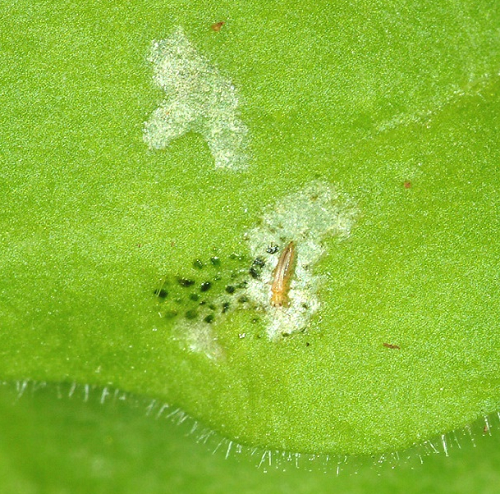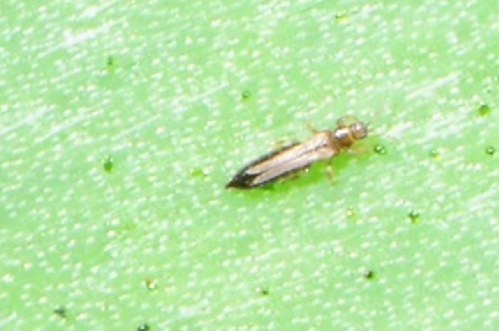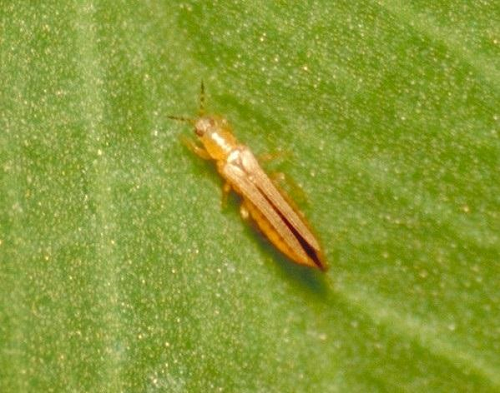Onion and Western Flower Thrips
ENTFACT-328: Onion and Western Flower Thrips | Download PDF
by Nathan Mercer, Lab Technician, and Ric Bessin, Extension Specialist
University of Kentucky College of Agriculture
Introduction
Thrips are minute insects with feathered wings. Both the plural and singular forms of the name are thrips (a thrips, many thrips). They are poor fliers that rely on wind for dispersal and have been found as high up as 10,000 ft. Some species of thrips are predatory and can be beneficial by feeding on other thrips and mites. However, most species of thrips feed on plants and some can cause serious damage to crops and ornamentals. Thrips damage plants in three ways. The first is by using their piercing-sucking and rasping mouth parts to feed on plant sap. Thrips damage is easily identifiable by the silver scaring caused by feeding and the black speckle fecal remains (Fig. 1). The second is by laying their eggs into the plant causing tissue scarring. The third is by transmitting plant viruses. The two most common thrips pests in Kentucky are the onion thrips (Thrips tabaci) (Fig. 2) and the western flower thrips (Frankliniella occidentalis) (Fig. 3). This ENTFact will cover the biology of these two thrips species and how to manage them.

Figure 1. A thrips and its feeding damage
Thrips have six life stages beginning with the egg which is partially buried in the plant tissue. First instar nymphs emerge from the egg and begin feeding on the plant tissue, soon molting into the second instar. Two non-feeding stages called the prepupae and pupae follow the first two instars and are found usually in the soil. The final stage is the adult, which is easily identified by the presence of wings. Onion and western flower thrips perform well in a hot, dry climate, which helps to accelerate their life cycle. Hot and dry conditions can also stress plants, worsening the damage caused by thrips.

Figure 2. Onion thrips

Figure 3. Western flower thrips
Onion and western flower thrips are very similar to the naked eye, and a hand lens will be needed to identify the thrips species. Adults of both these pest species are dark to light brown. This differentiates them from two of the predatory species, the six spotted thrips and the black hunter thrips (Fig. 4). The six spotted thrips is pale yellow with three dark spots on each of its forewing and the black hunter is black with two clear bands across its wings. Characteristics for to identify onion and western flower thrips from one another are in the following table.

Identification to species is critical for determining which management actions to use as onion and western flower thrips are susceptible to different insecticides and depending on the crop, may or may not require treatment. Whether dealing with onion or western flower thrips, it is important to remember that management is much more successful using multiple strategies, rather than relying on a single strategy.

Figure 4. Black hunter thrips nymph
Onion Thrips
Onion thrips originate from the Mediterranean and are a major pest of onions and related crops such as garlic. Onions are the preferred host and most damaged by onion thrips. Onion thrips are also found feeding on a wide range of other plants, such as alfalfa, but do not cause economic damage to these crops. Adult onion thrips overwinter in the soil around onions, small grain and hay fields. Adults live for 3 weeks and will continuously lay eggs during this time. In Kentucky, onion thrips can develop from egg to adult in as little as 20 days and can have 6-8 generations per year. Feeding damage in severe infestations can cause a 30-50% reduction in bulb size.
In addition to damage caused by feeding, onion thrips also transmit viruses, iris yellow spot virus being of the most concern. This virus causes straw to tan colored lesions on leaves which result in dead leaves and reduces bulb size up to 60%. Onion are the most sensitive to onion thrips feeding when plants are young and bulbs are growing. Onion thrips feeding damage coupled with damage from the virus has the potential to lead to complete crop failure if left unmanaged. Onion thrips can continue to feed on the bulb after harvest and in storage, leading to physical defects and reducing quality of the bulb.
Management of onion thrips begins during selection of planting date and field location. Planting faster maturing varieties early in the season can help avoid high thrips densities which develop later in the growing season. Avoid planting near alfalfa and small grains if possible. Onion thrips can feed and reproduce on these crops and can migrate from them into onion fields. Nitrogen is a limiting resource for onion thrips and limiting this nutrient to your plant can help to reduce onion thrips. Overhead irrigation systems can also help to wash thrips off plants and water droplets can inhibit feeding on plants. Removing plant debris and volunteer onions after harvest can reduce thrips numbers in the next season.
No onion cultivars are highly resistant to onion thrips, but white and yellow onion varieties tend to have greater resistance to thrips feeding. Onion varieties with yellow-green leaves, glossy leaf surfaces and an open neck are less attractive to onion thrips than blue-green waxy leaves with a tight neck. Biological control can be used to suppress thrips as well. Predatory mites, such as Neoseiulus (Amblyseius) cucumeris and Amblyseius swirskii, or green lacewings, if purchased as eggs or larvae stage, can be used in all manner of cropping systems. If the crop is in a high tunnels or greenhouse minute pirate bugs, Orius insidiosus and adult are also viable biological control agents. These last two insects are only recommended for enclosed spaces because they are likely to fly away from the release location.
Scouting for onion thrips can be done with visual inspection of plants and sticky cards. Infestations usually begin along the field edge and is where scouting should focus at the beginning of the season. Minimum recommendations for scouting onions is to search 10 sets of five plants. On each of these plants search the neck of the onion, focusing on the younger leaves, which the thrips prefer. Sticky cards should be placed along the edge of the crop and checked weekly. Sticky cards should preferably be blue as this is more attractive than yellow to thrips.
There are several insecticides available in Kentucky for onion thrips. As stated before, identification of thrips species is critical for determining which insecticides to use. Chemical action should be taken when 10 to 25 thrips are found per onion plant. At least two insecticide applications should be made, spaced five days apart. Thrips eggs and pupae are protected from sprays, so at least two insecticide applications spaced five days apart are needed to kill multiple generations of thrips. There are several biorational, organic and conventional insecticides available for onion thrips which can be found in the “Vegetable Production Guide for Commercial Growers ID-36” (http://www2.ca.uky.edu/agcomm/pubs/id/id36/id36.pdf). Onion thrips can develop resistance to insecticide quickly and it is therefore strongly encouraged to rotate active ingredients among successive sprays, reducing the chance of resistance build up.
Western Flower Thrips
The western flower thrips were originally from the western US, but began to spread in the 1960s and are now a global pest. Western flower thrips attack a wide range of plants including: carnations, chrysanthemums, corn, cotton, cucumbers, eggplants, gerberas, grapes, impatiens, melons, peaches, peanuts, peas, and peppers. There are also numerous weedy plants that are suitable hosts as well. As their name suggests, Western flower thrips prefer to live in blooms of many plants. Western flower thrips populations can develop very quickly under warm, dry conditions. In the optimum temperature range of 68°F and 98°F, western flower thrips can develop from egg to adult in only seven days. Adult female thrips can produce 100-200 eggs over her lifetime.
Damage caused to plants is similar to onion thrips, however this species can transmit a different set of viruses including tomato spotted wilt virus, tomato chlorotic spot virus, impatiens necrotic spot virus and groundnut ringspot virus. These viruses can cause significant damage and mortality to plants. Identification of these diseases must be done by a specialist because the symptoms vary greatly among plant species and environmental conditions. When bringing in new plant material to your greenhouse or high tunnel you should thoroughly inspect it for thrips and virus signs to prevent accidental infestations.
There are several different management practices you can use to help reduce and prevent yield loss from western flower thrips. The first major management practice to utilize is sanitation. Disposing of unneeded plant material is important to reduce thrips abundance. In the case of floriculture, this means removing any unmarketable flower. Western flower thrips can survive winters outdoors in Kentucky but their survival is improved when sheltered in greenhouses, high tunnels, or during mild winters. Remove any plant residue from your greenhouses and high tunnels after harvesting including any weeds that may provide alternative hosts for western flower thrips during the winter. If possible, use fertilizers with lower nitrogen. Using plastic mulch that reflects UV light can interfere with western flower thrips ability to find host plants.
Biological control agents can also be released for control of western flower thrips. See the onion thrips section for a list of biological control agents.
For pesticide application it is important to first scout properly. Much like onion thrips, sticky cards can be used to monitor for the presence of western flower thrips. Focus inspections on blooms of the plant. Holding a sticky card in front of a flower and tapping the back of the flower can knock thrips out of the flower and onto the sticky card for easy identification and counting. Again, identification is important because different thrips species are susceptible to different insecticides. When selecting insecticides, it is important to rotate modes of action to reduce the chance of insecticide resistance build up. Much like onion thrips, at least two applications should be made so that any western flower thrips that were in a protected life stage during the first spray will be hit by the second.
For vegetable specific chemical recommendations, see “Vegetable Production Guide for Commercial Growers ID-36” (http://www2.ca.uky.edu/agcomm/pubs/id/id36/id36.pdf) or “Midwest Fruit Management Guide ID-232” (http://plantpathology.ca.uky.edu/files/id-232.pdf)
Revised: 08/20
CAUTION! Pesticide recommendations in this publication are registered for use in Kentucky, USA ONLY! The use of some products may not be legal in your state or country. Please check with your local county agent or regulatory official before using any pesticide mentioned in this publication.
Of course, ALWAYS READ AND FOLLOW LABEL DIRECTIONS FOR SAFE USE OF ANY PESTICIDE!
